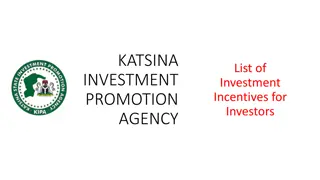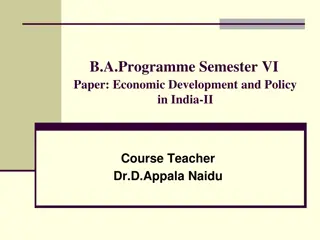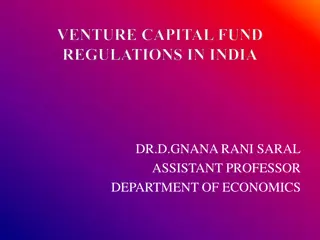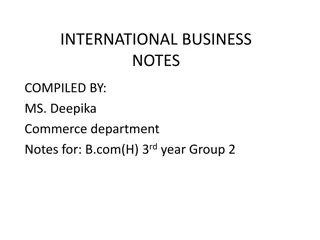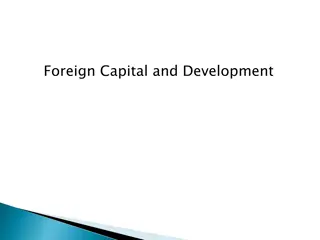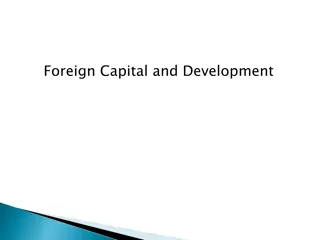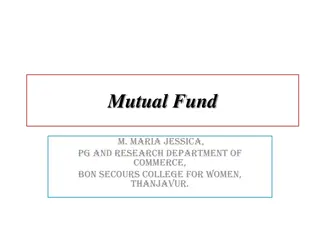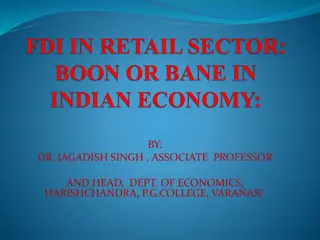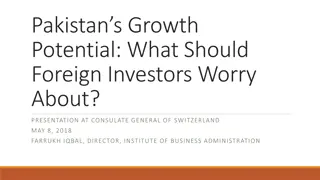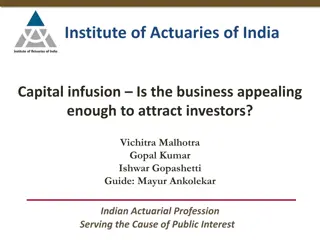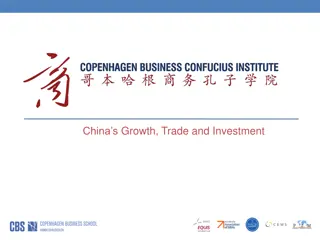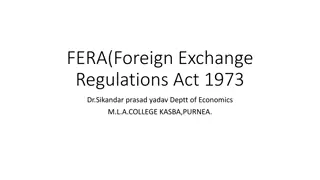Foreign Direct Investment in India: Key Insights for Investors
India's manufacturing sector is a top destination for Foreign Direct Investment (FDI), with key highlights showcasing its growth potential and attractiveness to investors. The country received significant FDI flows from countries like Singapore, USA, Japan, and the Netherlands in various industries like manufacturing, financial services, and construction. The entry process for FDI in India includes sectors under automatic and approval routes, with different permissible business structures like Wholly Owned Subsidiary, Joint Venture Partner, and more. Understanding these aspects is crucial for investors looking to capitalize on India's growing economy.
Uploaded on Oct 10, 2024 | 1 Views
Download Presentation

Please find below an Image/Link to download the presentation.
The content on the website is provided AS IS for your information and personal use only. It may not be sold, licensed, or shared on other websites without obtaining consent from the author.If you encounter any issues during the download, it is possible that the publisher has removed the file from their server.
You are allowed to download the files provided on this website for personal or commercial use, subject to the condition that they are used lawfully. All files are the property of their respective owners.
The content on the website is provided AS IS for your information and personal use only. It may not be sold, licensed, or shared on other websites without obtaining consent from the author.
E N D
Presentation Transcript
FDI IN MANUFACTURING SECTOR IN INDIA
KEY HIGHLIGHTS Asia s one of the biggest buying economy. By 2025, India will become the fifth largest consumer goods market in the world. INDIA THE GROWTH STORY India is the third-most attractive destination for FDI (after china & USA) in the world India is one of the world s youngest nations. India s appeal lies in its competitive labor costs, lucrative domestic market, and its skilled workforce.
Country-wise FDI flow in India during the FY 2018-19 (US$ million) 863853 817 Singapore 1,211 982 Mauritius USA 2,519 Japan 14,632 Netherlands United Kingdom 2,745 South Korea Cayman Islands 2,823 UAE Germany 6,570
Industry-wise FDI flow in India during the FY 2018-19 (US$ million) Manufacturing 2,009 2,427 7,919 Financial Services 2,597 Communication Services Retail & Wholesale Trade 3,453 Computer Services Business services 6,372 Electricity and other energy Generation, Distribution & Transmission Construction 4,311 5,365
FDI ENTRY PROCESS & SUITABLE BUSINESS STRUCTURE
FDI ENTRY PROCESS Sectors in which 100% FDI is freely permitted and no prior government approval is required. The GOI has placed a significant majority of sectors under the automatic route of Investment Automatic Route Contains the list of sectors for which the automatic route of investment is not available and prior approval from is required No further clearance from RBI is required in order to receive inward remittances and issue shares to foreign investors Approval Route There are some activities, in which foreign investment is prohibited Some examples: Gambling & betting, lotteries, atomic energy, business of Chit funds etc. Prohibited Activities
FIND OUT SUITABLE BUSINESS STRUCTURE FORM Wholly Owned Subsidiary (WOS) Liaison Office (LO) Registered as an Indian Company (Incorporated Registered as a Foreign Company (Unincorporated Entities) Joint Venture Partner (JV) Branch Office (BO) Entities) Limited Liability Partnership (LLP) Project Office (PO)
INCORPORATED ENTITIES Private Limited Company (WOS & JV) Limited Liability partnership A foreign company may set up a WOS in sectors where 100% FDI is permitted under the FDI policy. Alternatively, it could enter into a joint venture with an Indian partner, which may entail the following advantages for a foreign investor: A Limited Liability Partnership (LLP) is an alternative corporate business form that gives the benefits of limited liability of a company and the flexibility of a partnership. It is governed by the provisions of the Limited Liability Partnership Act, 2008. An LLP can continue its existence irrespective of changes in partners. It is capable of entering into contracts and holding property in its own name. It is a separate legal entity and is liable to the full extent of its assets but the liability of the partners is limited to their agreed contribution in the LLP. Furthermore, no partner is liable on account of the independent or unauthorized actions of other partners. Mutual rights and duties of the partners within an LLP are governed by an agreement between the partners or between the partners and the LLP, as the case may be. Established distribution/marketing set-up of the Indian partner Available financial resources of the Indian partner Established contacts of the Indian partner, which help smoothen the process of setting up operations A foreign company incorporated as either of these two entities under the Companies Act is treated at par with any domestic Indian company within the scope of approval and subject to all Indian laws and regulations as applicable to other domestic Indian companie
UNINCORPORATED ENTITIES Branch Office ("BO") Project Office ("PO") Liaison Office ("LO") To represent the parent company in India BOs are permitted to represent the parent and undertake activities in India such as export/ import of goods, rendering professional services, carrying out research work Activities as per contract to execute project LO can not undertake any commercial activity and can not earn any income in India PO can be set up to execute specific projects in India and cannot undertake or carry on any activity other than the activity relating and incidental to the execution of the project LO can act as a channel of communication between the principal place of business or head office and entities in India. It can promote export/import from/to India and also facilitate technical/financial collaboration between the parent company and companies in India.
NATURE OF ACTIVITIES The selection of form of entity for investment into India should be based on; TAX PERIOD OF INVESTMENT CONSIDERATI ON BUSINESS MODEL FOR THE INDIAN OPERATION
CURRENT SCENERIO Ranked 2nd most favorite destination for foreign investment after china India ranked among the top 12 producers of manufacturing value added (MVA) India s automotive market is world s 4th and 5th largest market in PV & CV respectively In electrical machinery and apparatus, it is ranked 5th 7th in chemicals and chemical products The sector s gross value added (GVA) at basic prices based at current prices is estimated at US$ 403.47 billion in FY19 6th position an basic metal category
Sector-wise FDI Inflow from April 2000 to December 2019 (In US$ billion) Automobilie industry 3 Drugs & Pharmaceuticals 5 5 24 Chemicals (Other than Fertilizers) Food Processing 9 Electrical Equipments Cement 10 Textiles 16 Electronics 17
Government Initiatives Domestic consumption PPP Growth Drivers in Manufacturing Sector in India International investments Huge labor pool
Huge domestic market with a rapidly increasing middle class and overall population. Increasing share of young working population in the total population. Robust Demand India has all the necessary ingredients for its major industrial push a huge semi- skilled labor force, multiple government initiatives like Make in India, high investments and a big domestic market. Increasing Investment Initiatives like make in India and sector specific initiative to various manufacturing companies, aiming make India a global manufacturing hub. Policy Support
FDI up to 100% is permitted in all manufacturing activities except prohibited sectors and; Defense Industry - Foreign investment beyond 49% has now been permitted through government approval route. The defense sector is also subject to an industrial license (IL) regime, which is provided by the DIPP and Ministry of Commerce, in consultation with the MoD Pharmaceuticals (Brownfield)74% FDI under automatic route has been permitted in brownfield pharmaceuticals. FDI beyond 74% is allowed through government approval route. Manufacturing of cigars, cheroots, cigarillos and cigarettes, of tobacco or of tobacco substitutes .
SETTING UP OF BUSINESS ENTITY FOR MANUFACTURING SECTOR
REGISTRATION/FORMATION OF INCORPORATED ENTITY Procure Director Identification Number (DIN) & Digital Signature Certificate (DSC) for proposed directors of Indian Investee Company Prepare Charter Documents (Memorandum of Association & Articles of Association) and other incorporation documents and submit with E-forms with Ministry of Corporate Affairs The Ministry of Corporate Affairs after scrut issue Certificate of Registration and Certificate of commencement of Business in India Procure necessary regulatory registrations like, GST (Goods & Service Tax), PAN (Permanent Account Number), TAN (Withholding tax account number), IEC (Import Export Code) OR any other industry specific registration Post incorporation Reporting to Reserve Bank of India (RBI)
REGISTRATION/FORMATION OF UNINCOPORATED ENTITY STEP I. Take approval from Authorized Dealer ("AD") Bank / Reserve Bank of India ( RBI") The foreign company shall submit Form FNC-1 along with charter documents, details of the management of the foreign company and other supporting documents with RBI through AD Bank. The RBI after scrutiny of documents and after getting satisfied with the information issues permission to establish LO/BO/PO STEP II. After taking approval/Permission from AD Bank / RBI, the Foreign Company will have to get registered with Registrar of Companies, Ministry of Corporate Affairs The foreign company shall submit E-Form FC-1 with Ministry of Corporate Affairs along with RBI permission letter and other specified documents. The Ministry shall approve the registration of LO/BO/PO and issues Certificate of establishment of Business in India.
THANK YOU Harish Malhotra Partner Wywode Jurists New Delhi I Mumbai I Barcelona T: 011 49050196, 47586533 E: info@waywodejurists.Com


